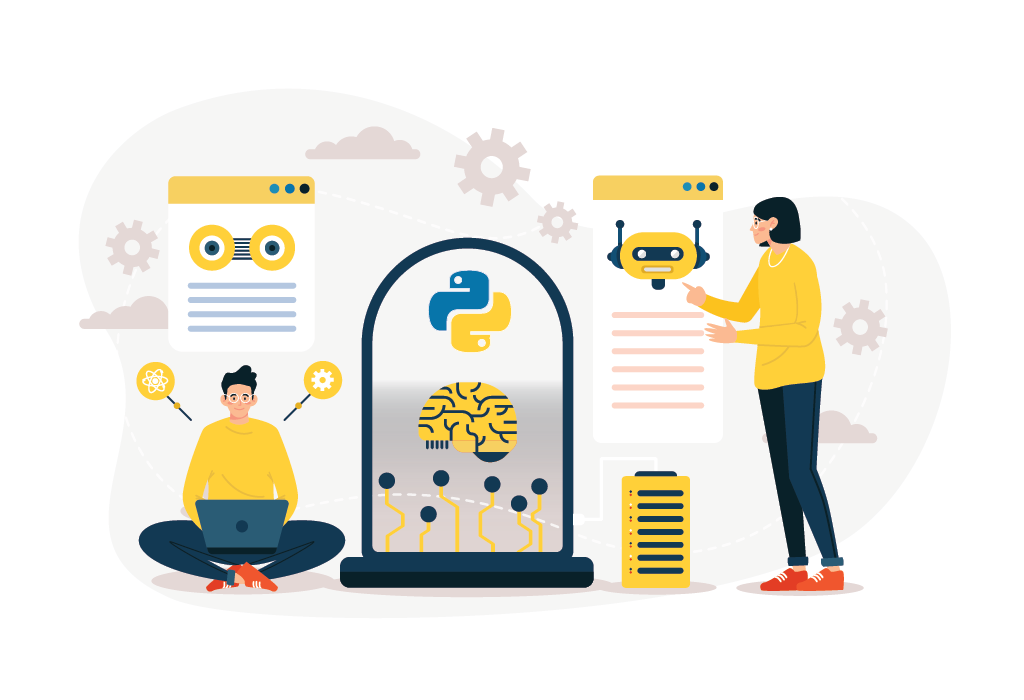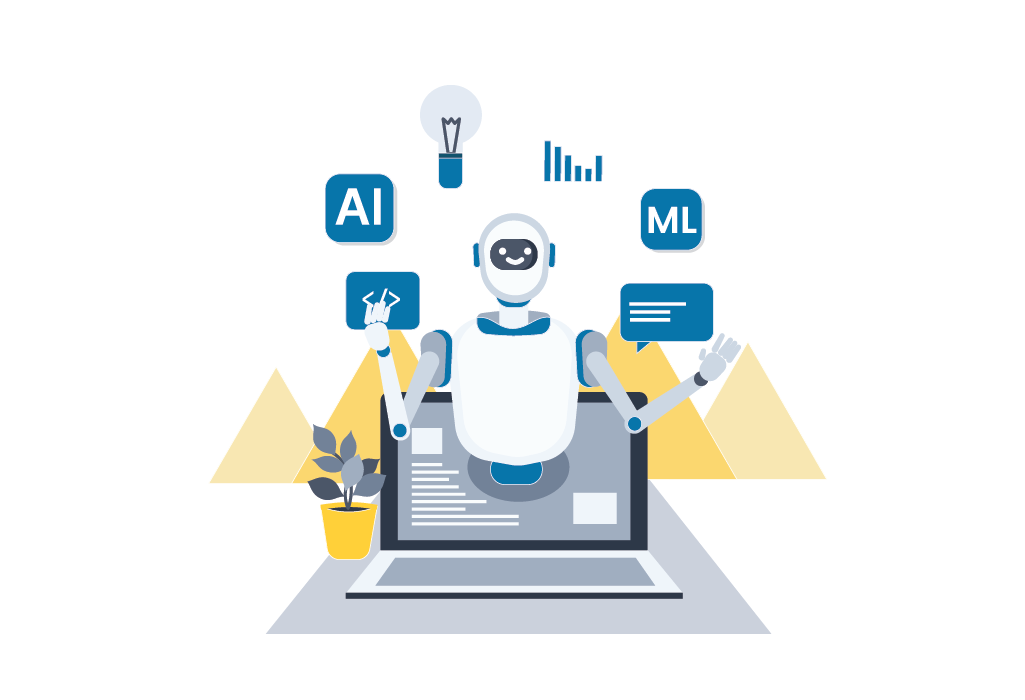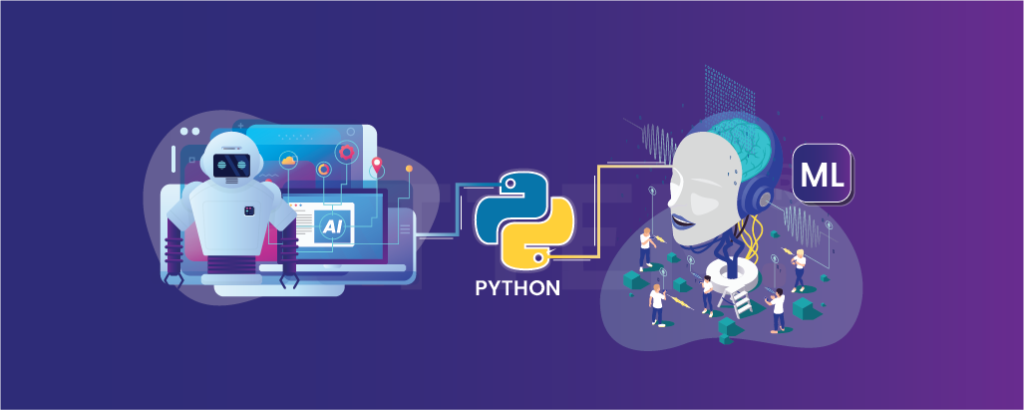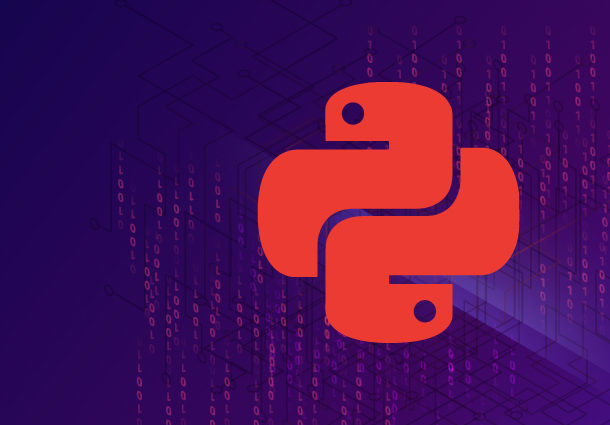Python: The inimitable champion for Artificial intelligence and Machine learning
In the quickly evolving disciplines, Python has emerged as the best programming language for AI & machine learning(ML) and artificial intelligence(AI), ushering in a revolution. Python’s aptitude for simplicity, adaptability, and robust library ecosystem have propelled it to the top spot as the language of choice for developing AI and ML applications. To illustrate why Python has emerged as the undisputed leader in this sector, this blog examines Python’s key capabilities, renowned libraries, and how it has developed into the engine enabling ground-breaking AI and ML systems.
In the current technological environment, where organizations are fervently working to develop AI-driven apps, the choice of a programming language is essential. With its skill in decreasing code complexity and enabling flawless implementation, Python has unquestionably ascended to the top of this emerging area. Python shines as a real giant in the domains of artificial intelligence (AI), data science, and machine learning (ML), which are the center of constant attention at the moment. It differs from its rivals by assuring unsurpassed usability through the provision of straightforward and versatile tools.
Programmers can alter Python’s functionality to suit their needs thanks to the language’s built-in extensibility, which is a pleasant feature. The incredibly wide range of libraries that Python enthusiasts have access to—a priceless resource for anything related to AI and ML—adds to this appeal. However, Python’s fundamental appeal extends beyond these technical virtues and stems from the sizable Python community of virtuosos who are devoted to working together to push the boundaries of expertise and creativity. As the intricate web of AI-based applications develops, Python remains the coveted pioneer of a flawless harmony between the human brain and cutting-edge technology.
Pioneering AI and ML Solutions with Python
In today’s data-driven economy, the emergence of massive and complex datasets has necessitated the usage of AI and ML for analysis and processing. The amount of processing the human brain can perform depends on how much information it can take in at once. These constraints are lifted by artificial intelligence, allowing it to handle massive datasets with ease.  AI’s precision and insights increase productivity while reducing production costs and raising business output. Numerous sectors are currently utilising AI and ML to boost productivity and promote product development, taking use of these cutting-edge technologies’ disruptive potential. Python’s unique qualities are essential in the hands of specialists using AI and ML to get the best results in a variety of industries. Through intelligent automation and data-driven decision-making, language is increasingly becoming a driving force in the transformation of enterprises. This can be due to its accessibility, wide range of library resources, and strong community backing. These characteristics help Python play the role of a catalyst for business transformation, where intelligent automation and data-driven insights are key to the advancement of organizations.
AI’s precision and insights increase productivity while reducing production costs and raising business output. Numerous sectors are currently utilising AI and ML to boost productivity and promote product development, taking use of these cutting-edge technologies’ disruptive potential. Python’s unique qualities are essential in the hands of specialists using AI and ML to get the best results in a variety of industries. Through intelligent automation and data-driven decision-making, language is increasingly becoming a driving force in the transformation of enterprises. This can be due to its accessibility, wide range of library resources, and strong community backing. These characteristics help Python play the role of a catalyst for business transformation, where intelligent automation and data-driven insights are key to the advancement of organizations.
- Jupyter Notebooks’ popularity: Python’s work on AI and ML has come to be known as Jupyter Notebooks, an interactive web-based computing environment. By enabling academics and developers to combine code, visualizations, and documentation in a single document, they promote collaboration and information exchange. AI testing has undergone radical changes as a result of the capacity to run code in portions and see results all at once, fostering innovation and promoting research.
- Public benevolence and open source: Python has a vibrant and enthusiastic community, which aids in the language’s growth. This collaborative mentality has led to the development of several open-source AI and ML projects. Developers can use these community-led initiatives to advance existing development and common knowledge. Python’s open-source nature complements AI and ML concepts elegantly, fostering transparency, innovation, and accessibility for all.
- Capabilities for Integration: Python’s popularity is significantly impacted by its versatility in terms of how it works with various operating systems and programming languages. Developers may easily interface Python with C/C++, Java, or R to benefit from established codebases or add additional features. By removing any obstacles to adoption, this seamless connection makes it simpler for developers from all backgrounds to move to Python as their best language for AI development and Machine learning.
- Libraries for AI and ML: Scikit-learn: Special consideration should be given to Scikit-learn, a popular Python library for machine learning. An extensive selection of algorithms for classification, regression, clustering, and other tasks are available in this robust and user-friendly library. Scikit-learn enables developers to quickly prototype ML models, allowing them to concentrate on the main problems of their AI projects rather than becoming mired down in implementation details.
Python’s dominance as the best programming language for machine learning and artificial intelligence
Python reigns supreme as the ultimate programming language for machine learning and artificial intelligence. Boasting a wealth of libraries, Python’s user-friendly syntax empowers developers to create intricate models and algorithms. Its ubiquitous presence underscores its indispensable role in shaping the landscape of AI-driven advancements.
Libraries and Frameworks in Abundance:
Python’s appeal is derived from a wide range of libraries and frameworks that easily integrate with AI/ML development. The editor may easily import these pre-written code modules, enabling developers to call functions with ease. Prime examples include spaCy and Natural Language Toolkit (NLTK), which cater to language processing jobs, and Scikit-learn, a repository of various ML methods including linear regression and support vector machines. TensorFlow, PyTorch, and Keras libraries are also enthusiastically embraced by the AI community, further enhancing the language’s dominance. Python advances in the field of AI/ML with regards to additional powerhouses like NumPy, Pandas, and Seaborn that make data manipulation simple.
Intuitive Syntax Mimicking Natural Language:
Python’s acclaimed popularity stems from its intuitive syntax, which resembles natural language and is reminiscent of colloquial English. Developers’ learning curves are sped up by the intrinsic simplicity of the code, which makes it easier to understand and use. An uncluttered and efficient coding experience is made possible by the substitution of indentation for cumbersome brackets.
Dynamic Interpretation without Recompilation:
Python’s dynamism enables developers to make changes without delay and see effects right away, unlike other languages that demand frequent recompilation. This exceptional adaptability speeds up the development process and places it at the forefront of AI and machine learning using Python.
Platform-Agnostic Adaptability:
Python’s code portability makes it platform-independent and able to be executed in a variety of contexts, including Windows, Mac, UNIX, and Linux. Python’s appeal in the AI/ML community is increased by its unmatched adaptability, which guarantees cross-platform capability.
Support from a Vast Global Community:
The Python community is a thriving global force that contributes to the language’s dominance as an open-source programming language. At every level of competence, a thriving community of aficionados is available to help. This priceless assistance encourages ongoing innovation and a collaborative environment for debugging code. Python is king of AI and ML, as shown in the travel, fintech, transportation, and healthcare sectors.
- Travel: An important player in the travel sector, Skyscanner, used Python’s unsupervised ML algorithm to forecast demand for new flight routes and predict passenger behavior. By comparing tens of thousands of origins and destinations to 30 criteria, they are able to quickly identify profitable routes and improve the travel experiences of their clients. The leading travel company Skyscanner employed Python’s unsupervised ML algorithm to forecast traveler behavior and demand for new flight routes.
- Fintech: The fintech industry makes substantial use of Python’s adaptability to support crucial operations like fraud detection, credit scoring, and financial forecasting. The robust library ecosystem of the language helps businesses to create complex algorithms, enhancing security and accuracy in decision-making processes, hence protecting financial systems. Python is used in Fintech to strengthen security and decision-making processes by being used for fraud detection, credit scoring, and financial forecasting.
- Transportation: Through route optimization, fleet management, and demand forecasting, Python enables transportation businesses to increase operational efficiency. They optimize resource allocation through the use of Python’s strong libraries and tools, which results in cost-effectiveness and simplified logistics. For fleet management, demand forecasting, and route optimization that improves operations and costs-effectiveness, transportation businesses use Python.
- Healthcare: Python’s adaptability is seen in the healthcare industry, where it is essential for disease detection, medical picture analysis, and drug development. Its strong libraries, including TensorFlow and PyTorch, make it possible to create cutting-edge models of AI using Python that will revolutionize medical care with accurate diagnoses and fresh treatment modalities. Python advances patient care and treatment methods in the healthcare industry by helping with disease diagnosis, drug discovery, and medical picture analysis. The ongoing development of Python’s AI and ML capabilities will foster creativity and influence technology-driven solutions across industries.
Recapitulating the crux of digital development
Python is the undisputed leader in the fields of artificial intelligence and machine learning thanks to its extensive library collection, approachable syntax, dynamic execution, cross-platform flexibility, and the unending support of its international community.  Python propels developers into a world of virtually endless possibilities in AI and ML by utilizing these powerful characteristics.
Python propels developers into a world of virtually endless possibilities in AI and ML by utilizing these powerful characteristics.
Python’s versatility, usability, extensive library ecosystem, and strong community support have all contributed to its rise as the leading programming language for AI and machine learning. Developers may easily design complicated AI and ML models using libraries like NumPy, Pandas, Scikit-learn, TensorFlow, and PyTorch, fostering innovation across a variety of industries. Python is widely used and a favorite among developers from a variety of backgrounds due to its integration possibilities and language compatibility. Python’s dominance in this field is set to increase as AI develops, revolutionizing how humans interact with technology and pushing the limits of what is conceivable in AI.
Elevate your aspiration: Choose the pinnacle of exemplary service excellence
For all needs in digital development, Pattem Digital stands out as an excellent option as a Python development company. For companies eager to turn their vision into reality, their unmatched knowledge, client-centric philosophy, innovation-driven mindset, and dedication to quality make them enduring and trusted partners. With Pattem Digital at your side, you can relax knowing that your digital journey is in competent hands and will lead to the unmatched success of your company.
Client satisfaction is at the heart of all we do at Pattem Digital. We take the time to comprehend your particular needs and then customize our solutions to meet them. To guarantee that your digital projects are delivered on time, within budgetary constraints, and with the highest precision, our team of trained professionals puts forth unrelenting effort. We maintain your involvement throughout the development process using a collaborative and agile approach, encouraging open communication and transparency. Our objective is to surpass your expectations and provide your company with powerful digital solutions. Join together with Pattem Digital today to maximize the potential of your digital endeavor.


